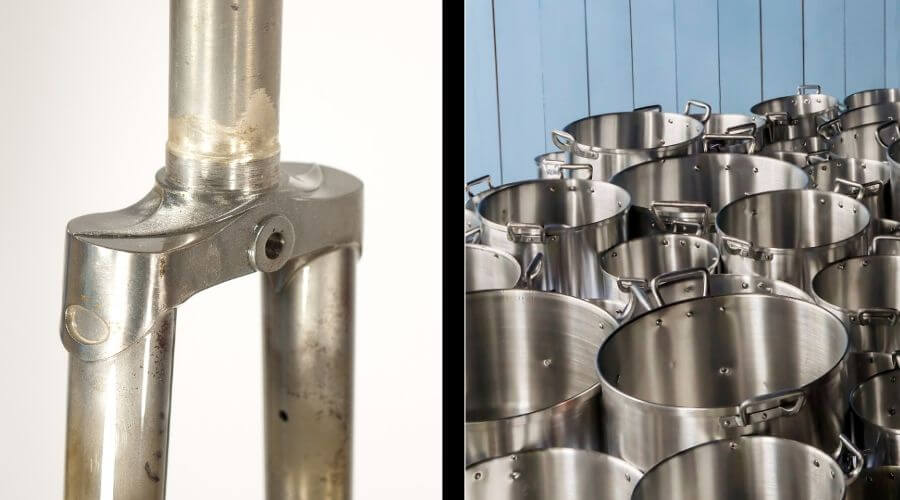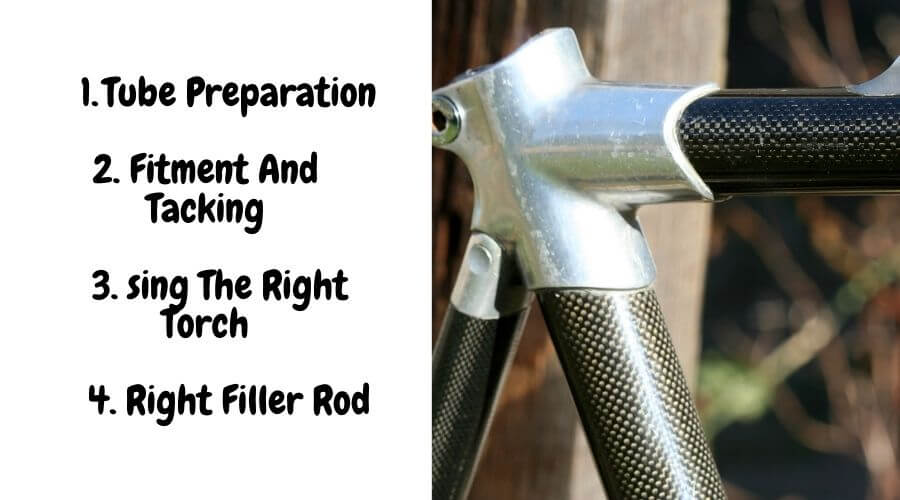Chromoly or Chrome Moly is the short form of chromium-molybdenum steel. It is a popular alloy steel containing chromium and molybdenum as key alloying elements. The steel is famous for its durability, strength and rust resistance.
It is a weldable metal and can be fused together to form any structure. Now the question is can you mig weld chromoly steel? Well, that’s what I’ll be trying to answer here today.
In short, The answer is yes, you can weld a chrome-moly steel. If you thrive to mig weld thinner chromoly (less than 0.120inch), you don’t need to preheat it. But for thicker metal (more than 0.120in) like chromoly tubing, you must preheat it to 300-400°F for better results.

What Is Chromoly And Its Composition?
Chromium molybdenum steel, often referred to as Chromoly, is 41xx series alloy steel. It is not like regular steel & is known for its impressive tensile strength and malleability. We often see Chrome-moly being used around us in different applications.
It falls in alloy steel grade 4130, where 41 refers to the alloy itself and the 30 refers to the carbon content of 0.30%. Due to its high carbon content, Chromoly is a very strong and hard metal. The rest of Chromoly is made of chromium and molybdenum containing 0.8-1.1% and 0.15-0.25% respectively. (matmatch)
Can You MIG Weld Chromoly To Mild Steel?
Before I answer this question, we should know about mild steel to better understand the answer. So, mild steel is one type of carbon steel with low carbon content.
If we look at the definition of Chromoly or chrome-moly, we can see that mild steel is the complete opposite of Chromoly in terms of carbon contents. Unlike Chromoly, mild steel is not an alloy, containing only iron.
Now, about the question. Yes you can MIG weld Chromoly to mild steel, but there are some catches and challenges. They are
- Strength Discrepancy: Chromoly steel is often stronger and has different mechanical properties compared to mild steel. Welding them together may result in an inconsistent joint strength.
- Temperature Sensitivity: Chromoly and mild steel have different coefficients of thermal expansion. This can lead to varied rates of expansion and contraction during welding, potentially causing stress and distortion and crack in the joint.
- Voltage and Amperage Settings: Finding the right settings for voltage and amperage is crucial when welding dissimilar materials. It may require adjustments to accommodate the different melting points and thermal conductivity of chromoly and mild steel.
- Post-Weld Heat Treatment: Chromoly steel is often heat-treated to enhance its properties. However, the heat input from welding can alter the material’s microstructure, potentially leading to brittle welds. Post-weld heat treatment may be necessary to restore the material’s strength and toughness. Mostly for mild steel tubing to chrome moly, preheating and post heating are crucial works to do.
- Avoiding Contamination: Cross-contamination of filler materials can occur if the same welding equipment is used for both chromoly and mild steel without proper cleaning.
- Corrosion Resistance: The combination of chromoly and mild steel may lead to different corrosion resistance characteristics.
Can You MIG Weld Chromoly To Stainless Steel?

The answer to this question is pretty much the same as the previous one. There are some issues, but apart from those, you can weld Chromoly to stainless steel.
However, due to the difference in content, it’s not easy to MIG weld Chromoly to stainless steel.
In order to put Chromoly to stainless steel, you’ll need a filler material called super missile weld that has a high chromium content in it. Using the filler metal you’ll get a nice and strong weld with a beautiful appearance. But the weld joint of chromoly to stainless steel would be short-lived.
You will face some challenges while mig welding chrome moly to stainless steel too. They are-
- Dissimilar Characteristics: Chromoly and stainless steel have different compositions. Achieving a strong, reliable & perfect weld between dissimilar materials can be challenging.
- Differential Rates: During welding, the materials heat up and cool down at different rates, potentially leading to distortion, stress, and cracking in the welded joint.
- Matching Filler Metals: Choosing the right filler material is crucial. Selecting a filler material that is suitable for both chromoly and stainless steel is important for achieving a strong and corrosion-resistant weld.
- Careful Execution: The welding technique needs to be carefully selected to ensure proper fusion between chromoly and stainless steel. Adequate penetration and bonding are essential for a reliable weld.
- Quality Control: Thorough testing and inspection, such as visual inspection or non-destructive testing methods, can help identify potential issues and ensure the integrity of the welded joint.
Requirements For MIG Welding Chromoly
At this point, I hope you have already realized that MIG welding Chromoly is a little more complex than welding other alloys. However, it’s doable, and some steps can help you pull this off flawlessly.
These are pretty simple yet crucial steps to successfully MIG weld Chromoly.

Tube Preparation
First thing you need to ensure before MIG welding Chromoly is that you have the right Chromoly tube. In most applications, Chromoly is used as tubes, but it can be a sheet or something else, depending on the project.
Now, whatever workpiece you have, make sure that it doesn’t contain any residue on it from cutting. If there are residues left, it can affect both the appearance and durability of the welding. So before MIG welding the pipe, don’t forget to grind & clean it thoroughly.
If you have a sander available around you, sand the tube at a moderate speed to smoothen the surface of it.
Fitment And Tacking
Now comes the next step of the process, which is fitment and tacking. Chromoly is infamous for its heat sensitivity. As MIG welding provides less heat control, make sure you don’t expose Chromoly directly to heat. Instead of high speed at once, increase the heat input gradually at a consistent rate. So, don’t forget to keep a tighter arc length to prevent stubbing out.
To maintain a proper weld alignment, you should tack weld Chromoly. Use smaller tack welds for an aligned and durable welding result.
As for the fitment, make sure there is no space in between the base metal & workpiece when you close it. This space is the sole reason to create a larger heat affected zone (HAZ). Eventually, you’ll end up with brittles around the affected area.
Using The Right Torch
Welding torch plays an important role in getting the desired output from welding. When you are MIG welding Chromoly, choosing the right torch becomes even more important because of how delicate the job is. As mentioned previously, you need to move forward slowly with low speed to MIG weld Chromoly.
So, for a welding job choosing a lightweight torch can provide you with convenience for a flawless welding result.
Choose The Right Filler Rod
This step is arguably the most important part of MIG welding Chromoly, as the filler material will decide the final result of the welding. There are three filler wire options available for Chromoly welding, ER80S-D2, ER70S-2 and 4130 variants of Chromoly alloy. Each of them has their advantages. Also their usage varies depending on availability and projects.
- ER80S-D2 and ER70S-2 are two of the most common filler metals for Chromoly welding. The first one has almost similar strength to Chromoly itself. In comparison, the weld strength of ER70S-2 is slightly lower, around 10,000 less than ER80S-D2.
- Lastly, 4130 Chromoly is used when you need a heat-treated Chromoly weld or match the materials. However, keep in mind that 4130 can’t be used with Chromoly tubes with thin walls.
Process Of Mig Welding Chromoly
Apart from the steps I mentioned above, there are a few points I would like to mention here. These tips will give a more efficient welding experience.
- Slow and steady wins the race. If you want crack-free welded Chromoly with deeper penetration, weld at a moderate speed.
- Preheating is standard practice for MIG welding Chromoly, but many welders don’t understand that there is a certain limit. If your tube is thin enough, like under 0.120 inches, you can easily get away without preheating and still get a decent result. To thicken you must preheat the meatal to some extent.
- When you control slope in welding, make sure to shift from downslope to upslope gradually. Doing so will help you avoid brittle around the welded area.
Tips: For any welding metal like chromoly, you shouldn’t try to cool it down fast. Let the cooling happen just from the normal room temperature. Forcing the cooling process can lead to distortion and reduced ductility of the metal.
Problems With MIG Welding Chromoly
Though I mentioned several times that MIG welding Chromoly is doable, it comes with certain problems. Now, whether these problems will be deal-breakers entirely depends on you and your project.
- First of all, MIG welding is not a good choice in terms of heat control, and you can easily end up with Chromoly tubes cracking after the weld. If you want perfect and precise welding the chromoly, try Tig welding.
- Another issue with MIG welding is, it doesn’t generate enough heat to penetrate Chromoly all the time. As a result, the weld won’t be as strong as you may expect.
Despite these problems, if you have the right mig wire, moderate wire feed and skillset, you can go for MIG welding Chromoly any time.
What You Need To Do To MIG Welding Chromoly Bike Frame
MIG welding Chromoly bike frames isn’t usually a great idea, but it’s doable. Also, you’ll notice lots of arguments about whether you can MIG weld a Chromoly bike frame!
Chromoly is a very common material used for bike frames, mostly bicycle frames. Now, the issue with MIG welding Chromoly frames is that the frame tubes are pretty thin.
As MIG welding is mostly used for heavier projects with thick metal pieces like chromoly tubing, it’s pretty challenging to weld Chromoly with lower heat control of MIG welding. Even if you managed to weld a Chromoly bike frame, you’d have lots of spatters.
Tips: Having said these things, you can still MIG welding Chromoly bike frames. Just take it slow and travel the torch at the right angle at a slower rate. Additionally, make sure the penetration is consistent at all times while welding.
How Strong Is Chromoly Alloy?
Chromoly is a high density and hard metal. Its density ranges from 0.264 – 0.287 lb/in³. Its hardness ranges from 26-67, average ultimate tensile strength is 1490 megapascals (MPa), and the average yield strength is 1220 MPa. Its average values of elongation at Break and Yield are 14.4% and 15.0%, respectively. (matweb)
You easily imagine how strong the metal is. Generally, the application of Chromoly is a good indicator of how strong an alloy it is. Starting from the automobile industry to the oil and gas industry, Chromoly has various applications that require extreme durability.
Now, if we look on paper, there are three key elements in Chromoly, which are carbon, chromium and molybdenum. Both carbon and molybdenum provide excellent strength to the alloy with mechanical stability in high heat.
Lastly, the chromium adds better hardenability and corrosion resistance. All these qualities combined, Chromoly alloy can be considered a pretty strong substance with a much higher weight to strength ratio.
Wrapping Up
As you can see, it’s quite possible to MIG weld chromoly tubing with proper guidelines and skill set. So, if you have any projects that require MIG welding chromoly, just boot up and get to welding. With my guidelines, you’ll easily get a smooth and strong Chromoly weld in no time.
Related Article
